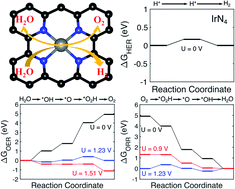Atomically dispersed iridium catalysts for multifunctional electrocatalysis†
Abstract
Development of high-performance multifunctional electrocatalysts is of great interest for renewable energy systems. Here, an atomically dispersed iridium embedded nitrogen-doped graphene electrocatalyst (Ir@NG-750) is synthesized through a simple annealing method. The atomic Ir@NG-750 catalyst exhibits excellent electrocatalytic performance for the oxygen reduction reaction in both acidic and alkaline media with half-wave potentials of 0.77 V and 0.865 V, respectively, together with good durability, a four-electron pathway, and excellent resistance to carbon monoxide poisoning. It also shows outstanding electrochemical performance for the hydrogen evolution reaction, providing low overpotentials of 114 mV and 25 mV at 10 mA cm−2 in 0.1 M KOH and 0.5 M H2SO4, respectively. Moreover, it displays superior catalytic performance for the oxygen evolution reaction with low overpotentials of 273 mV, 340 mV, and 371 mV at 10 mA cm−2, in 1.0 M KOH, 0.1 M KOH and 0.5 M H2SO4, respectively. Due to its excellent trifunctional properties, it can deliver an overall water splitting current density of 10 mA cm−2 at a cell voltage of 1.7 V. In addition, the Ir@NG-750-based Zn–air battery exhibits a peak power density of 56.8 mW cm−2 at a voltage of 0.62 V. DFT calculations reveal that the IrN4–G center is the active site for these reactions.



 Please wait while we load your content...
Please wait while we load your content...